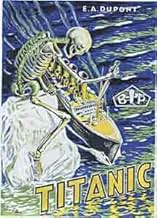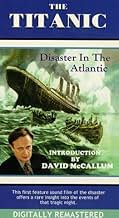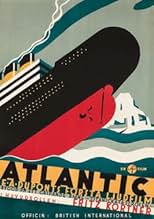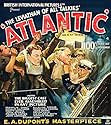Aggiungi una trama nella tua linguaOn its maiden voyage in April 1912, the supposedly unsinkable RMS Titanic hits an iceberg in the Atlantic Ocean.On its maiden voyage in April 1912, the supposedly unsinkable RMS Titanic hits an iceberg in the Atlantic Ocean.On its maiden voyage in April 1912, the supposedly unsinkable RMS Titanic hits an iceberg in the Atlantic Ocean.
- Regia
- Sceneggiatura
- Star
Gordon James
- Capt. Collins
- (as Sydney Lynn)
Recensioni in evidenza
True this movie is creaky by today's standards. It's a British maritime story & British production directed by a German Expressionists director who himself was getting acquainted with sound at the time. I had waited a long time to see this film in it's entirety when I found a video two-tape copy in a Sam Goodys. Before I had only seen clips of this in Titanic documentaries. If the Producers changed the Title from Titanic to Atlantic it was more in conjunction with the movie being made only 17 years after the real disaster. Many of the survivors' relatives would have been alive and well and lawsuits would have probably abounded from them as well as The White Star Line, the Titanic's owner, which was still up and running and had an image to uphold. Remember at this time the White Star Line considered the Titanic as a ship they'd rather forget. But even with the title being Atlantic the film's makers infringed upon an earlier White Star disaster in 1873 with over 300 lives lost. The ship from the 1873 disaster was called: THE ATLANTIC. The biggest White Star disaster 39 years before the Titanic.
This movie, based on an earlier stage production, was a big undertaking for 1929 sound film. Dupont is obviously a novice with sound technique. Dialogue from characters such as Tate-Hughes is often spoken in a slow-witted fashion presumably for some kind of stage effect. Characters are given names to protect the identities of the real life victims. So Captain EJ Smith-becomes-"The Captain", Charles Lighttoller-becomes-simply "Lanchester", Ben Guggenheim-becomes-"Tate-Hughes" albeit in a wheel chair and so on. Charleston type music is played instead the Ragtime & Waltzes that were actually heard on the Titanic. But Dupont set a standard with this film that all later Titanic films imitated in one way or another. This film shows the goings-on on the bridge, scenes of the engine room(pretty good by the way), the effects on important first class passengers, the steerage passengers in the lower holds and the sinking, while very stagey, is handled poignantly with the cast singing Nearer My God To Thee...this was imitated in the 1953 Titanic w/Barbara Stanwyck. But there was no visual aspect of the actual ship sinking. Perhaps a bit to harrowing to portray since it was only 17 years and the disaster would've still been fresh in some survivors minds.
Most Titanic buffs should want to see this just to see how 1929 audiences would have handled the sinking of the Titanic as told through a fictional ship called Atlantic. It's an obvious story on the Titanic but done to protect survivors & relatives of which many were living at the time. Seeing this, one can compare it to Titanic(1953), A Night To Remember(1958 classic), the made for tv S.O.S Titanic(1979) or the recent James Cameron Oscar winner. I would give it just for historical purposes 2 1/2 stars out of 4.
This movie, based on an earlier stage production, was a big undertaking for 1929 sound film. Dupont is obviously a novice with sound technique. Dialogue from characters such as Tate-Hughes is often spoken in a slow-witted fashion presumably for some kind of stage effect. Characters are given names to protect the identities of the real life victims. So Captain EJ Smith-becomes-"The Captain", Charles Lighttoller-becomes-simply "Lanchester", Ben Guggenheim-becomes-"Tate-Hughes" albeit in a wheel chair and so on. Charleston type music is played instead the Ragtime & Waltzes that were actually heard on the Titanic. But Dupont set a standard with this film that all later Titanic films imitated in one way or another. This film shows the goings-on on the bridge, scenes of the engine room(pretty good by the way), the effects on important first class passengers, the steerage passengers in the lower holds and the sinking, while very stagey, is handled poignantly with the cast singing Nearer My God To Thee...this was imitated in the 1953 Titanic w/Barbara Stanwyck. But there was no visual aspect of the actual ship sinking. Perhaps a bit to harrowing to portray since it was only 17 years and the disaster would've still been fresh in some survivors minds.
Most Titanic buffs should want to see this just to see how 1929 audiences would have handled the sinking of the Titanic as told through a fictional ship called Atlantic. It's an obvious story on the Titanic but done to protect survivors & relatives of which many were living at the time. Seeing this, one can compare it to Titanic(1953), A Night To Remember(1958 classic), the made for tv S.O.S Titanic(1979) or the recent James Cameron Oscar winner. I would give it just for historical purposes 2 1/2 stars out of 4.
Yes I know "talkies" had just been invented for the cinema 2 years earlier when this was produced in 1929 but this film showed that much had to learnt about the art of producing films.It comes over as a filmed "hammy" stage play with the actors melodramatically enunciating their lines,rolling their eyes, using too many pregnant pauses and using gestures more appropriate to silent cinema, which I suppose was normal during the process of educating them to appear more naturalistic on screen.The gaps between lines spoken should have been tightened up during editing as it considerably slows the film.It is now only of interest for Titanic buffs who want to see an early example of this marine accident on film.In next chronological order they could see "Titanic" (1953) A Night to Remember (1958)"Titanic (1997), to see how the cinema's depiction of this tragedy as evolved over the years.There have been many documentaries and TV films made including the atrocious "SOS Titanic" (1979) On my version which is a DVD, David McCallum gives the introduction.It was he who played Harold Bride Marconi's junior wireless operator in "A Night to Remember"(still the best feature film - please read my "Tribute to Walter" comments on IMDb under Howard Morley.demon.co.uk)and gave the commentary on the series of 4 videos entitled "End of a Dream" so he was well qualified to give the narration.Of more interest I found was a recording accompanied by actual photos of the 1912 US Senate hearing which is also on the DVD.Actors speak the actual words spoken by Lightoller 2nd officer, J Bruce Ismay,Managing director of White Star, Harold Bride and others including Gloria Stewart (The "old Rose" in Titanic 1997) whose voice is used for one of the first class women survivors.
Try to focus on the actual disaster, having just occurred sixteen, seventeen years earlier than when this film came out, and see what was known, what was rumored, what was accepted to have happened, and not dwell on the rawness of the film-making.
Well, that was near impossible to do, right up to the end. I thought Alfred Hitchcock's "Murder" (which came out about the same time) was about one of the most experimental films I had ever seen, but I think this one might outdo it.
The sound is awful, but a silent film done well, or a totally non-talking piece, such as what Laurel & Hardy did, could be just as entertaining, if it has a good story structure. Well, this movie can't claim that either.
Hands down, that mother constantly weeping about her nerves and pressing the hankie to her mouth because she has learned her husband was cheating on her was a constant irritation. Oh, if only she had gone down with the ship!
As with the Barbara Stanwyck-Clifton Webb-Robert Wagner 1953 version, this film delved into adultery. No idea why that theme was always attached to the sinking.
Franklin Dyall, father of the impressive Valentine Dyall (best known for Doctor Who appearances to the American audience) strived for his best Lionel Barrymore, but was outdone in two seconds by Elaine Terriss as his wife, in her brief appearance when she learned he wouldn't enter a lifeboat.
Even to a novice like me, there clearly was a problem with direction; with how sound on the film would sound as opposed to dialogue delivered on stage, as well as to how it was recorded.
I was dumbstruck by Dyall questioning Manchester "you seem to think this is damn serious?"
Wasn't it a really big deal when Clark Gable said 'Damn' in "Gone With the Wind"?
Oh, he was a MAJOR star. A major star doing that. I see.
And I look at most depictions of Blacks in these old films as being historical, but to put a pair of Blacks on this thing just to have them shot because they try to storm the lifeboats I'm sure didn't help race relations back then. While these were actual Black people and not blackface, I tend to try to think how much the performers enjoyed working and getting to dive off the boat like that.
Other than the 1912 version with actual Titanic survivor Dorothy Gibson in it, wearing the outfit she was wearing when she was rescued, this stands as about the earliest version of the disaster. No idea what that Italian 1915 film could be, if it is even based on the ship-in-question.
This film was to be titled Titanic, but outrage and sensitivity toward the event, which again, had just occurred sixteen years earlier, saw a retitling, and it became "Atlantic".
The version I have on tape has a reworked title with the old stock footage of the doomed liner and it is now titled "Titanic". As a film, I would have preferred the original title to be present.
As it is, scenes of the film's disaster, and for that matter still shots I have seen from this movie, did not match up to what was present here, so I'm not sure what is going on as far as editing goes.
There are other Titanic movies depicting the ship to check out, but if you are a buff, like me, you enjoy checking out as many different versions of the Titanic that you can find.
Of all I have seen now (S.O.S. Titanic, 1943 German version, Cameron's Titanic, Night To Remember, George C. Scott-Catherine Zeta Jones, 1953, Unsinkable Molly Brown, even have the recent musical soundtrack), this one has to be the worst.
Well, that was near impossible to do, right up to the end. I thought Alfred Hitchcock's "Murder" (which came out about the same time) was about one of the most experimental films I had ever seen, but I think this one might outdo it.
The sound is awful, but a silent film done well, or a totally non-talking piece, such as what Laurel & Hardy did, could be just as entertaining, if it has a good story structure. Well, this movie can't claim that either.
Hands down, that mother constantly weeping about her nerves and pressing the hankie to her mouth because she has learned her husband was cheating on her was a constant irritation. Oh, if only she had gone down with the ship!
As with the Barbara Stanwyck-Clifton Webb-Robert Wagner 1953 version, this film delved into adultery. No idea why that theme was always attached to the sinking.
Franklin Dyall, father of the impressive Valentine Dyall (best known for Doctor Who appearances to the American audience) strived for his best Lionel Barrymore, but was outdone in two seconds by Elaine Terriss as his wife, in her brief appearance when she learned he wouldn't enter a lifeboat.
Even to a novice like me, there clearly was a problem with direction; with how sound on the film would sound as opposed to dialogue delivered on stage, as well as to how it was recorded.
I was dumbstruck by Dyall questioning Manchester "you seem to think this is damn serious?"
Wasn't it a really big deal when Clark Gable said 'Damn' in "Gone With the Wind"?
Oh, he was a MAJOR star. A major star doing that. I see.
And I look at most depictions of Blacks in these old films as being historical, but to put a pair of Blacks on this thing just to have them shot because they try to storm the lifeboats I'm sure didn't help race relations back then. While these were actual Black people and not blackface, I tend to try to think how much the performers enjoyed working and getting to dive off the boat like that.
Other than the 1912 version with actual Titanic survivor Dorothy Gibson in it, wearing the outfit she was wearing when she was rescued, this stands as about the earliest version of the disaster. No idea what that Italian 1915 film could be, if it is even based on the ship-in-question.
This film was to be titled Titanic, but outrage and sensitivity toward the event, which again, had just occurred sixteen years earlier, saw a retitling, and it became "Atlantic".
The version I have on tape has a reworked title with the old stock footage of the doomed liner and it is now titled "Titanic". As a film, I would have preferred the original title to be present.
As it is, scenes of the film's disaster, and for that matter still shots I have seen from this movie, did not match up to what was present here, so I'm not sure what is going on as far as editing goes.
There are other Titanic movies depicting the ship to check out, but if you are a buff, like me, you enjoy checking out as many different versions of the Titanic that you can find.
Of all I have seen now (S.O.S. Titanic, 1943 German version, Cameron's Titanic, Night To Remember, George C. Scott-Catherine Zeta Jones, 1953, Unsinkable Molly Brown, even have the recent musical soundtrack), this one has to be the worst.
No movie with Madeleine Carroll in its cast could possibly be unwatchable. That said, I have to add that this British film comes close. The story takes place on board the `SS Atlantic' and it's loosely based on the `Titanic's' unfinished voyage. The word `unsinkable' is spoken, the liner strikes an iceberg, and we hear a heavenly choir sing `Nearer My God to Thee.' The doomed passengers eventually take over the anthem, in a clever bit of sound work. But the year of the film's release (1929) means that a modern viewer has to accept otherwise primitive sound and many of the acting conventions of silent films and the stage. These aren't problems. The film's major flaw is pacing, and pacing had been well developed in silents. However, if the dialog were delivered at a realistic speed, the movie's running time would be cut in half. The intended effect was drama (and clarity in a new medium), but the result unhappily is tiresome now. The film's structure is preposterously illogical and inept. Paradoxically, I found certain details of the editing quite modern in technique: fine, abrupt cuts from one area of the ship to another, sometimes even on sound effects. Although we're on board the `Atlantic' from the first shot, we were well over 4 minutes into the movie before I discovered that fact. There are long, intrusive musical passages by the ship's dance orchestra. (Entertaining, easy sound.) Personal stories are presented in an utterly uninvolving and unconvincing way. Don't even think of spectacle. The berg is a tiny thing and the exterior damage it does to the ship's hull is a minor dent. However, the scenes of passengers swarming into the lifeboats - clearly staged on a real liner, presumably tied up to a dock - generate great excitement. Other than the glorious Miss Carroll, these sequences are the film's only points of excellence. As the movie and the ship near their end, the screen goes totally black several times when the power generators begin to fail. Their last, eternal blackout is the end of the film, with a sunset/sunrise tacked on, a clumsy symbolic effect. `Atlantic' is a cinema curiosity. At best.
From what I understand this was the first movie about the RMS Titanic that featured sound and it was produced in English, German and French (along with a silent version as well). The title was changed to "Atlantic" for fear of lawsuits. In any case, this film essentially depicts a small handful of passengers who have some interpersonal drama going on both before and after the ship hits the iceberg and begins to sink. Initially, most of the passengers are unaware that the ship is sinking which compounds the problem even more. At least that is the scenario that is portrayed in this particular film. Whether any of that is true or not is unknown to me. Be that as it may, I believe that in order for a person to enjoy this movie it is necessary to appreciate the era in which this film was made and for the viewer to make certain allowances for that fact. Likewise, although there have certainly been better films produced pertaining to the subject at hand, this is still a decent movie overall and I have rated it accordingly. Slightly above average.
Lo sapevi?
- QuizThe White Star Line forbade the production company from referring to the ship in this film as The Titanic.
- BlooperSet in 1912, he women's hairstyle and dresses are from 1929.
- Versioni alternativeReleased with separate English, French and German soundtracks.
- ConnessioniAlternate-language version of Atlantik (1929)
- Colonne sonoreWalking With Susie
(uncredited)
Written by G.H. Elliott
Played by the ship's band as Larry and Monica enter the Smoking Room.
I più visti
Accedi per valutare e creare un elenco di titoli salvati per ottenere consigli personalizzati
Dettagli
- Data di uscita
- Paese di origine
- Lingua
- Celebre anche come
- Titanic: Disaster in the Atlantic
- Luoghi delle riprese
- Azienda produttrice
- Vedi altri crediti dell’azienda su IMDbPro
Botteghino
- Budget
- 2000 £ (previsto)
- Tempo di esecuzione
- 1h 30min(90 min)
- Colore
- Proporzioni
- 1.20 : 1
Contribuisci a questa pagina
Suggerisci una modifica o aggiungi i contenuti mancanti



































